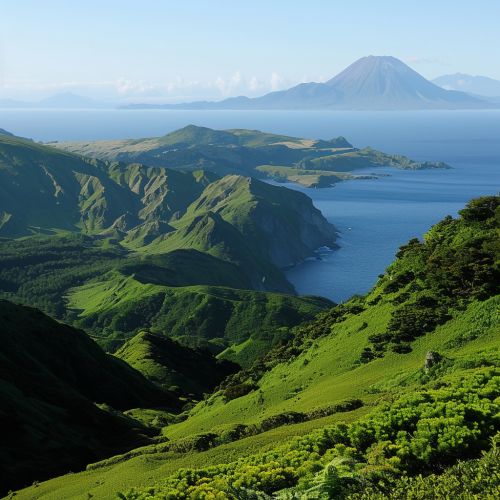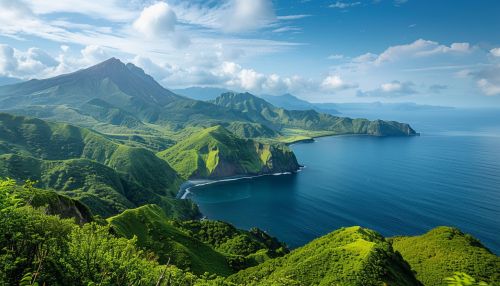Kuril Islands: Difference between revisions
(Created page with "== Geographical Overview == The Kuril Islands are a volcanic archipelago located in the northwest Pacific Ocean, stretching approximately 1,300 kilometers from the northeastern tip of Hokkaido in Japan to the southern tip of the Kamchatka Peninsula in Russia. The islands form part of the Pacific Ring of Fire and are characterized by their rugged terrain, numerous active volcanoes, and frequent seismic activity. The chain consists of 56 islands and many smaller i...") |
No edit summary |
||
| Line 3: | Line 3: | ||
The Kuril Islands are a volcanic archipelago located in the northwest Pacific Ocean, stretching approximately 1,300 kilometers from the northeastern tip of [[Hokkaido]] in Japan to the southern tip of the [[Kamchatka Peninsula]] in Russia. The islands form part of the Pacific Ring of Fire and are characterized by their rugged terrain, numerous active volcanoes, and frequent seismic activity. The chain consists of 56 islands and many smaller islets, which are divided into the Greater Kuril Ridge and the Lesser Kuril Ridge. | The Kuril Islands are a volcanic archipelago located in the northwest Pacific Ocean, stretching approximately 1,300 kilometers from the northeastern tip of [[Hokkaido]] in Japan to the southern tip of the [[Kamchatka Peninsula]] in Russia. The islands form part of the Pacific Ring of Fire and are characterized by their rugged terrain, numerous active volcanoes, and frequent seismic activity. The chain consists of 56 islands and many smaller islets, which are divided into the Greater Kuril Ridge and the Lesser Kuril Ridge. | ||
[[Image:Detail-91571.jpg|thumb|center|View of the Kuril Islands with volcanic peaks and lush green landscapes.|class=only_on_mobile]] | |||
[[Image:Detail-91572.jpg|thumb|center|View of the Kuril Islands with volcanic peaks and lush green landscapes.|class=only_on_desktop]] | |||
== Historical Context == | == Historical Context == | ||
Latest revision as of 16:01, 20 June 2024
Geographical Overview
The Kuril Islands are a volcanic archipelago located in the northwest Pacific Ocean, stretching approximately 1,300 kilometers from the northeastern tip of Hokkaido in Japan to the southern tip of the Kamchatka Peninsula in Russia. The islands form part of the Pacific Ring of Fire and are characterized by their rugged terrain, numerous active volcanoes, and frequent seismic activity. The chain consists of 56 islands and many smaller islets, which are divided into the Greater Kuril Ridge and the Lesser Kuril Ridge.


Historical Context
The history of the Kuril Islands is marked by a complex interplay of indigenous cultures, colonial ambitions, and international disputes. The Ainu people, indigenous to the region, were the earliest known inhabitants of the islands. European exploration began in the 17th century, with Russian and Japanese expeditions charting the archipelago. The Treaty of Shimoda in 1855 and the Treaty of Saint Petersburg in 1875 delineated the islands between Japan and Russia, but sovereignty disputes persisted.
Geology and Volcanology
The Kuril Islands are situated on the convergent boundary between the Pacific Plate and the North American Plate, resulting in significant geological activity. The islands are predominantly composed of volcanic rock, with numerous stratovolcanoes, calderas, and geothermal features. Notable volcanoes include Mount Tyatya, Mount Rausu, and Mount Chirip. The region experiences frequent earthquakes and tsunamis, contributing to its dynamic landscape.
Climate and Ecology
The climate of the Kuril Islands is classified as subarctic, with cold, snowy winters and cool, foggy summers. The islands' unique climatic conditions support a diverse range of flora and fauna. Vegetation includes boreal forests, tundra, and alpine meadows. The islands are home to various species of seabirds, marine mammals, and fish, including the endangered Steller sea lion and the Kuril Islands brown bear. The surrounding waters are rich in marine biodiversity, making the region an important area for fisheries.
Political and Legal Status
The Kuril Islands are currently administered by Russia as part of the Sakhalin Oblast, but Japan claims the southernmost islands, known as the Northern Territories. This territorial dispute has been a significant point of contention between the two nations since the end of World War II. Various diplomatic efforts have been made to resolve the issue, but a formal peace treaty has yet to be signed. The islands' strategic location and potential natural resources, such as oil and gas reserves, add to the complexity of the dispute.
Economic Activities
The economy of the Kuril Islands is primarily based on fishing, with the archipelago's waters being some of the richest fishing grounds in the world. The islands also have potential for tourism, particularly eco-tourism, due to their unique natural landscapes and wildlife. However, the remote location and harsh weather conditions pose challenges to economic development. There have been efforts to explore and exploit the islands' mineral resources, including geothermal energy, but these are still in the early stages.
Cultural Significance
The Kuril Islands hold cultural significance for the indigenous Ainu people, whose traditional lifestyle and customs are closely tied to the islands' natural environment. The Ainu have a rich oral tradition, with myths and legends that reflect their deep connection to the land and sea. Efforts are being made to preserve and promote Ainu culture, including language revitalization programs and cultural exchanges.
Environmental Concerns
The Kuril Islands face several environmental challenges, including the impact of climate change, overfishing, and pollution. Rising sea temperatures and changing ocean currents affect marine ecosystems, while overfishing threatens the sustainability of fish stocks. Pollution from industrial activities and marine debris also poses risks to the islands' fragile environment. Conservation efforts are crucial to protect the unique biodiversity and natural resources of the Kuril Islands.
See Also
- Pacific Ring of Fire
- Ainu People
- Sakhalin Oblast
- Steller Sea Lion
- Mount Tyatya
- Kamchatka Peninsula
- Hokkaido
